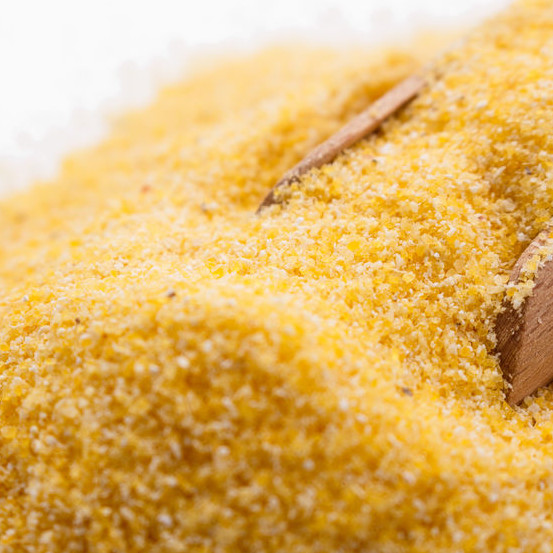
Grits
What are Grits?
Grits are coarse particles of ground endosperm from corn, hominy or soybeans. They are typically cooked to produce a porridge-like breakfast cereal. Traditionally, hominy grits are made from ground meal cooked in alkaline water. In baking, they are mainly used in corn bread and muffins.1
Different grades are available, such as:1
- Large: particles pass through a 1.19 mm sieve (US No. 14) and do not pass through 0.59 mm sieve (US No. 28)
- Regular: particles do not pass through a 0.42 mm sieve (US No. 40)
- Small: do not pass through a 0.25 mm sieve (US No. 60)
Origin
Grits are a traditional staple food in the southern US and are the official breakfast side dish in the state of Georgia. This product dates back to pre colonial times. Its origin is attributed to native American people who produced a mashed corn mixture. Over time, grits gained popularity and expanded across the Southern US.1
Function3,4
This ingredient perform several functions in baked goods:
- Flavor: white corn varieties provide a nice sweet flavor.
- Color: yellow corn varieties can impart a desirable yellow color.
- Texture: coarser grades are preferred over fine ones, which tend to form lumps
- Partial replacement for wheat flour: especially soybean kinds.6
- Provide structure: as a bulking agent.
- Absorbs liquids: help bind ingredients together.
Nutrition
Typical nutritional profile of white degermed corn grits per 100 grams:5
| Component | Grams |
| Water | 13.75 |
| Protein | 7.5 |
| Fat | 1.25 |
| Carbohydrate | 77.5 |
Grits are a good source of B vitamins and minerals and are low in fiber but rich in oil. Also, they are safe for celiac patients consumption. Grits contain lutein and zeaxanthin, antioxidants that may contribute to eye health.5
Commercial production1
Commercial production of grits uses the dry-milling process:
- Cleaning: corn is cleaned to remove impurities.
- Conditioning: water is added and the moisture content is equilibrated to allow the germ loosening.
- Degerming: removal and accumulation of the germ fraction.
- Drying: endosperm is dried to 15% moisture using rotary driers at 60-70 °C (140-158°F ).
- Cooling: to 32-38°C (90-100°F) with rotary or fluid bed coolers using ambient air.
- Grading: by particle size using a sifting device.
- Aspirating: for pericarp removal.
- Grinding: using roller mills to different particle sizes
- Sifting and classifying: corn grits and cornmeal are sifted to desired particle size and packed.
Application
Grits are typically consumed as an adjacent to savory meals. They are typically made by boiling in water and further addition of salt, pepper and butter.
Also, they can be used in the preparation of biscuits, bread, corn bread, spoon bread and muffins. The absence of gluten in corn grits and their yellow color often impacts the texture and organoleptic of baked goods.4
Soy grits can be used in the production of composite flours with no more than 10% substitution. Some adjustments should be considered when used in baked goods formulation such as:6
- Increasing yeast level
- Use lecithin or other emulsifiers
FDA regulations
Corn grits don’t have any specific FDA regulation due to their ancient food status. However, they need to comply with CFR 137.260 regarding product quality.7
References
- Matz, S.A. Chemistry and technology of cereals as food and feed. Springer Science & Business Media, 1991, pp. 497-509 .
- Murray, E. B. Grits: A Cultural and Culinary Journey Through the South. St. Martin’s Press, 2018, pp. 15-19.
- Figoni, P. How Baking Works: Exploring The Fundamentals Of Baking Science. 3rd ed., John Wiley & Sons, Inc., 2010, pp. 80-90.
- González-Victoriano, L., Güemes-Vera, N., Chanona-Pérez,J.J., Soto-Simental,S., Bernardino-Nicanor, A., González-Cruz, L and Hernández-Uribe,J.P. “Evaluation of Functional Properties and Physicochemical Characteristics of Flours Composed by Corn Grits and Oxalis tuberosa Flour, for Future Applications in the Elaboration of Nutritious Foods.” Pakistan Journal of Nutrition 18.3 (2019): 201-210.
- U.S. Department of Agriculture, Agricultural Research Service. FoodData Central, 10 August 2018. https://fdc.nal.usda.gov/fdc-app.html#/food-details/171330/nutrients. Accessed 17 June 2020.
- Berk, Zeki. Technology of production of edible flours and protein products from soybeans. 1992.
- Food and Drug Administration (FDA). US Department of Health and Human Services. CFR Code of Federal Regulations Title 21, Part 137 Cereal Flours and Related Products, https://www.accessdata.fda.gov/scripts/cdrh/cfdocs/cfcfr/CFRSearch.cfm?fr=137.260, Accessed 17 June 2020.

